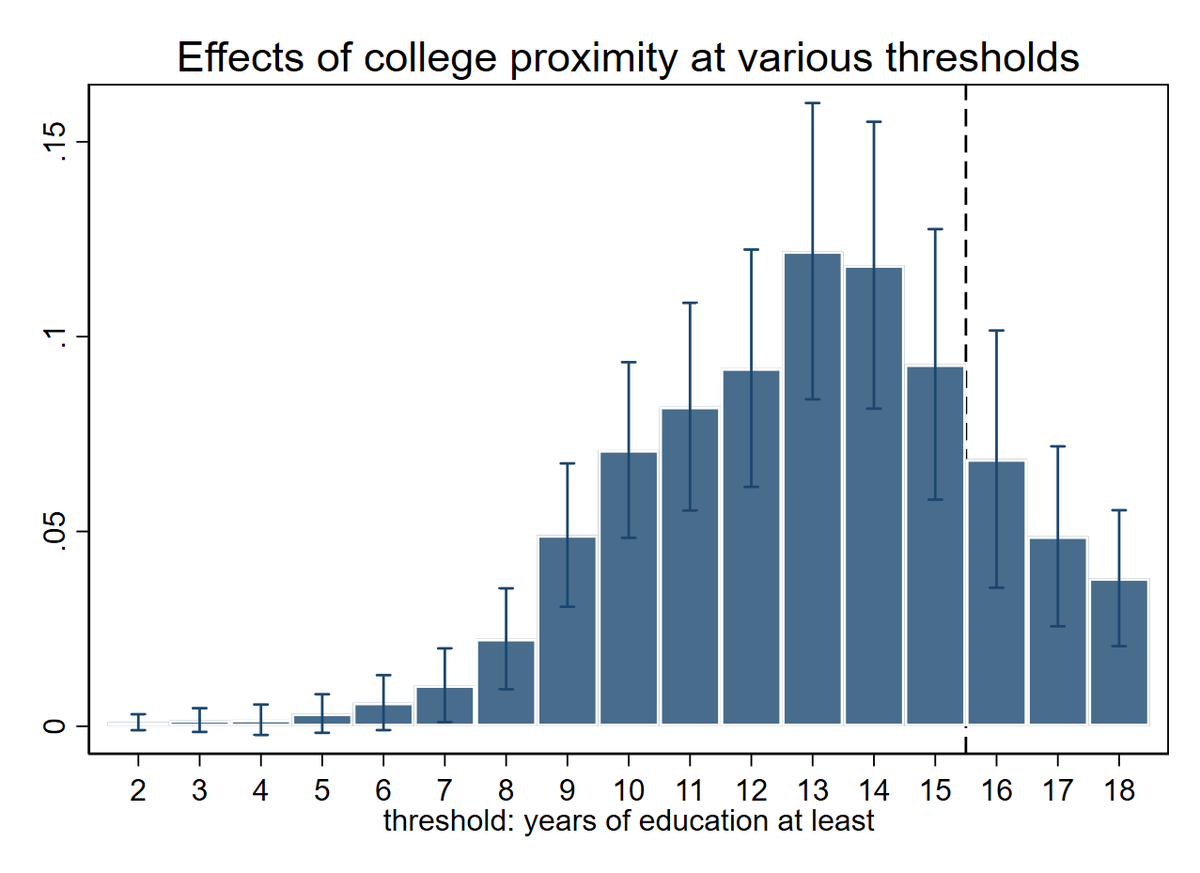New paper in The Econometrics Journal with @MHuberEcon: “Instrument-based estimation with binarized treatments: Issues and tests for the exclusion restriction”! We explore identifying assumptions and testable implications with IV when treatment is binarized. 1/n #EconTwitter
In applied work with instrumental variables, researchers often work with binary treatments such as a dummy for whether a defendant is incarcerated or not, whether a worker has a college degree or not or whether a child starts child care before or after age three. 2/n
When the underlying treatment is multivalued (length of the prison sentence, months in early care, years of education) it is well known that binarizing treatment may violate the exclusion restriction ( @metrics52 & Imbens 1995). 3/n
Marshall (2016) have shown identifying assumptions required to identify the effect of the multivalued treatment exactly at the threshold by using a binarized treatment, but these assumptions are often unlikely to hold in practice. 4/n
We show that an effect of the binarized treatment can be identified using considerably weaker assumptions: Either a) all compliers cross the threshold for binarization or b) there are no treatment effects for compliers who don’t. 5/n
Unfortunately for researchers, who binarize treatment to ease interpretation or because the threshold has policy relevance, the identified effect includes effects of off-threshold shifts in the multivalued treatment for compliers who are also induced to cross the threshold. 6/n
Importantly, this parameter is what you estimate when simply imposing the standard LATE assumptions on the binarized treatment, unless they are willing to impose much stronger assumptions on the first stage effect or treatment effects at off-threshold treatment levels. 7/n
We show that a) from above imply a particular relationship between the first stage coefficients using alternative thresholds. This can be used to test the validity of the exclusion restriction when the multivalued treatment is observed using conditional moment inequalities. 8/n
This gives applied researchers an additional tool to evaluate proposed research designs using conditional moment inequalities. Our tests may reject instrument validity even in cases where other tests in the literature do not. 9/n
The stronger assumptions in Marshall (2016) required to identify the effect of the multivalued treatment at the threshold may be tested using simple F-tests. All tests may be performed within cells of controls (or even the outcome), possibly increasing precision. 10/n
We illustrate our tests using distance to college as an instrument for 4-year college degrees in the NLSYM dataset (Card 1995), largely finding evidence against the exclusion restriction: 11/n
Although distance to college increases education, it does not exclusively shift people from education < college degree to education >= 4 yr college degree, it also induces people to take 2-year college degrees and further education. 12/n
Confused? Fear not, there is a Stata package available at http://github.com/martin-andresen/mvttest, building on the cmi_test command by Andrews et. al (2017). Bugs likely and feedback welcome 13/n
Although we focus on IV, methods in the paper can be used to test whether a treatment has effects only at a particular margin, conditional on monotonicity. As an example, one can test whether a randomized training program affects only the extensive margin of labor supply. 14/n
Finally, although our methods are most interesting when the multival15/15ued treatment is observed before binarization, these problems arise in any situation where the instrument can plausibly affect finer measures of the treatment than used as endogenous variable. Beware! 15/15
P.S.: The idea for this paper came up when @MHuberEcon, who sat on the committe for my PhD defense, correctly remarked that I binarized treatment. Three years later, this paper is published, while the original draft is still in my drawer. Very grateful he was on my committee!
Link to paper: https://academic.oup.com/ectj/advance-article-abstract/doi/10.1093/ectj/utab002/6126343

 Read on Twitter
Read on Twitter


